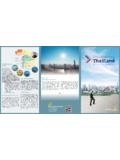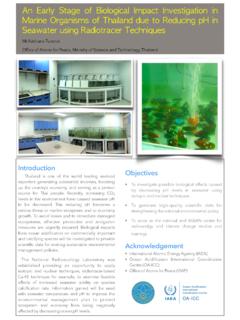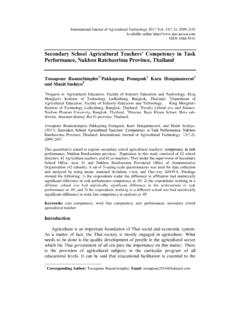Transcription of THE STATE OF THE WORLD’S CHILDREN 2011 - UNICEF
1 THE STATE OF THE world S CHILDREN 2011 AdolescenceAn Age of OpportunityTHE STATE OF THE world S CHILDREN 2011 ADOLESCENCE: AN AGE OF OPPORTUNITYU nited Nations CHILDREN s Fund3 United Nations Plaza New York, NY 10017, USAE mail: United Nations CHILDREN s Fund ( UNICEF )February 2011 Scan this QR code or go to the UNICEF publications website $ : 978-92-806-4555-2 Sales no.: United Nations CHILDREN s Fund ( UNICEF )February 2011 Permission to reproduce any part of this publication is required. Please contact:Division of Communication, UNICEF3 United Nations Plaza, New York, NY 10017, USATel: (+1-212) 326-7434 Email: will be freely granted to educational or non-profit organizations. Others will be requested to pay a small represent the personal views of the authors and do not necessarily reflect positions of the United Nations CHILDREN s Fund. The essays presented here are a selection of those received in mid-2010; the full series is available on the UNICEF website at < >For any corrigenda found subsequent to printing, please visit our website at < >For any data updates subsequent to printing, please visit < >ISBN: 978-92-806-4555-2 Sales no.
2 : Nations CHILDREN s Fund3 United Nations PlazaNew York, NY 10017, USAE mail: photo UNICEF /NYHQ2006-1326/Versiani UNICEF OfficesUNICEF HeadquartersUNICEF House3 United Nations PlazaNew York, NY 10017, USAUNICEF Regional Office for EuropePalais des NationsCH-1211 Geneva 10, SwitzerlandUNICEF Central and Eastern Europe/ Commonwealth of IndependentStates Regional OfficePalais des NationsCH-1211 Geneva 10, SwitzerlandUNICEF Eastern and Southern AfricaRegional Box 44145 Nairobi 00100, KenyaUNICEF West and Central AfricaRegional Box 29720 YoffDakar, SenegalUNICEF The Americas and Caribbean Regional OfficeAvenida Morse Ciudad del Saber ClaytonEdificio #102 Apartado 0843-03045 Panama City, PanamaUNICEF East Asia and the PacificRegional Box 2-15419 Phra Atit RoadBangkok 10200, ThailandUNICEF Middle East and North AfricaRegional Box 1551 Amman 11821, JordanUNICEF South Asia Regional Box 5815 Lekhnath MargKathmandu.
3 NepalFurther information is available at our website < >.Photo CreditsChapter opening photosChapter 1: UNICEF /NYHQ2009-2036/SweetingChapter 2: UNICEF /BANA2006-01124/MunniChapter 3: UNICEF /NYHQ2009-2183/PiresChapter 4: UNICEF /MLIA2009-00317/DickoChapter 1 (pages 2 15)* UNICEF /NYHQ2009-1811/Markisz UNICEF /NYHQ2009-1416/Markisz UNICEF /NYHQ2010-0260/Noorani UNICEF /NYHQ2007-0359/Thomas UNICEF /PAKA2008-1423/Pirozzi UNICEF /NYHQ2009-0970/Caleo UNICEF /MENA00992/Pirozzi Chapter 2 (pages 18 39)* UNICEF /NYHQ2009-2213/Khemka UNICEF /NYHQ2009-2297/Holt UNICEF M xico/Bel usteguiChapter 3 (pages 42 59)* UNICEF /NYHQ2005-2242/Pirozzi UNICEF /NYHQ2005-1781/Pirozzi UNICEF /NYHQ2006-2506/Pirozzi UNICEF /NYHQ2006-1440/Bito UNICEF /AFGA2009-00958/Noorani UNICEF /NYHQ2009-1021/Noorani UNICEF /NYHQ2004-0739/Holmes Chapter 4 (pages 62 77)* UNICEF /NYHQ2007-1753/Nesbitt UNICEF /NYHQ2004-1027/Pirozzi UNICEF /NYHQ2008-0573/Dean UNICEF /NYHQ2005-1809/Pirozzi US Fund for UNICEF /Discover the Journey UNICEF /NYHQ2007-2482/Noorani UNICEF /NYHQ2006-0725/Brioni*Photo credits are not included for Perspectives, Adolescent voices and Technology STATE OF THEWORLD S CHILDREN2011 THE STATE OF THE world S CHILDREN 2011ii This report was produced with the invaluable guidance and contributions of many individuals, both inside and outside of UNICEF .
4 Important contributions for country panels were received from the following UNICEF field offices: C te d Ivoire, Ethiopia, Haiti, India, Jordan, Mexico, Philippines, Ukraine and the US Fund for UNICEF . Input was also received from UNICEF regional offices and the world Health Organization s Adolescent Health and Development Team. Special thanks also to UNICEF s Adolescent Development and Participation Unit for their contributions, guidance and support. And thanks to adolescents from around the world who contributed quotations and other submissions for the print report and the STATE of the world s CHILDREN 2011 invited adult and adolescent contributors from a variety of stakeholder groups to give their perspectives on the distinct challenges adolescents face today in protection, education, health and participation. Our gratitude is extended to the contributors presented in this report: His Excellency Mr.
5 Anote Tong, President of the Republic of Kiribati; Her Royal Highness Princess Mathilde of Belgium; Her Highness Sheikha Mozah bint Nasser Al Missned; Emmanuel Adebayor; Saeda Almatari; Regynnah Awino; Meenakshi Dunga; Lara Dutta; Maria Eitel; Brenda Garcia; Urs Gasser; Nyaradzayi Gumbonzvanda; Colin Maclay; Cian McLeod; Paolo Najera; John Palfrey; Aown Shahzad; and Maria Sharapova. These essays represent a selection of the full series of Perspectives available at < >. Special thanks also to Ayman Abulaban; Gloria Adutwum; Rita Azar; Gerrit Beger; Tina Bille; Soha Bsat Boustani; Marissa Buckanoff; Abubakar Dungus; Abdel Rahman Ghandour; Omar Gharzeddine; Shazia Hassan; Carmen Higa; Donna Hoerder; Aristide Horugavye; Oksana Leshchenko; Isabelle Marneffe; Francesca Montini; Jussi Ojutkangas; and Arturo Romboli for their assistance with the Perspectives essay series and Technology panels. Special thanks also to Meena Cabral de Mello of WHO s Adolescent Health and Development Team for her assistance with the panel on adolescent mental AND RESEARCHD avid Anthony, Editor; Chris Brazier, Principal Writer; Maritza Ascencios; Marilia Di Noia; Hirut Gebre-Egziabher; Anna Grojec; Carol Holmes; Tina Johnson; Robert Lehrman; C line Little; Charlotte Maitre; Meedan Mekonnen; Kristin Moehlmann; Baishalee Nayak; Arati Rao; Anne Santiago; Shobana Shankar; Julia Szczuka; Jordan Tamagni; Judith Yemane PRODUCTION AND DISTRIBUTIONJ aclyn Tierney, Production Officer; Edward Ying, Jr.
6 ; Germain Ake; Fanuel Endalew; Eki Kairupan; Farid Rashid; Elias SalemTRANSLATIONF rench edition: Marc ChalametSpanish edition: Carlos Perell nMEDIA AND OUTREACHC hristopher de Bono; Kathryn Donovan; Erica Falkenstein; Janine Kandel; C line Little; Lorna O HanlonINTERNET BROADCAST AND IMAGE SECTIONS tephen Cassidy; Matthew Cortellesi; Keith Musselman; Ellen Tolmie; Tanya TurkovichDESIGN AND PRE-PRESS PRODUCTIONP rographics, TABLES Tessa Wardlaw, Associate Director, Statistics and Monitoring Section, Division of Policy and Practice; Priscilla Akwara; David Brown; Danielle Burke; Xiaodong Cai; Claudia Cappa; Liliana Carvajal; Archana Dwivedi; Anne Genereaux; Rouslan Karimov; Rolf Luyendijk; Nyein Nyein Lwin; Colleen Murray; Holly Newby; Elizabeth Hom-Phathanothai; Khin Wityee Oo; Danzhen YouPROGRAMME, AND POLICY AND COMMUNICATION GUIDANCEUNICEF Programme Division, Division of Policy and Practice, Division of Communication, and Innocenti Research Centre, with particular thanks to Saad Houry, Deputy Executive Director; Hilde Frafjord Johnson, Deputy Executive Director; Nicholas Alipui, Director, Programme Division; Richard Morgan, Director, Division of Policy and Practice; Khaled Mansour, Director, Division of Communication; Maniza Zaman, Deputy Director, Programme Division; Dan Rohrmann, Deputy Director, Programme Division; Susan Bissell, Associate Director, Programme Division; Rina Gill, Associate Director, Division of Policy and Practice; Wivina Belmonte, Deputy Director, Division of Communication; Catherine Langevin-Falcon; Naseem Awl; Paula Claycomb; Beatrice Duncan; Vidar Ekehaug; Maria Cristina Gallegos; Victor Karunan.
7 And Mima PressAcknowledgementsFOREWORDiiiForeword Last year, a young woman electrified a United Nations consultation on climate change in Bonn, simply by asking the delegates, How old will you be in 2050? The audience applauded. The next day, hundreds of delegates wore T-shirts emblazoned with that question including the Chair, who admitted that in 2050 he would be 110, and not likely to see the results of our failure to act. The young woman s message was clear: The kind of world she will live in someday relies both on those who inherit it and on those who bequeath it to them. The STATE of the world s CHILDREN 2011 echoes and builds on this fundamental insight. Today, billion adolescents stand at the challenging crossroads between childhood and the adult world . Nine out of ten of these young people live in the de-veloping world and face especially profound challenges, from obtaining an education to simply staying alive challenges that are even more magnified for girls and young women.
8 In the global effort to save CHILDREN s lives, we hear too little about adolescence. Given the magnitude of the threats to CHILDREN under the age of five, it makes sense to focus invest-ment there and that attention has produced stunning suc-cess. In the last 20 years, the number of CHILDREN under five dying every day from preventable causes has been cut by one third, from 34,000 in 1990 to around 22,000 in consider this: In Brazil, decreases in infant mortality be-tween 1998 and 2008 added up to over 26,000 CHILDREN s lives saved but in that same decade, 81,000 Brazilian adolescents, 15 19 years old, were murdered. Surely, we do not want to save CHILDREN in their first decade of life only to lose them in the second. This report catalogues, in heart-wrenching detail, the array of dangers adolescents face: the injuries that kill 400,000 of them each year; early pregnancy and childbirth, a primary cause of death for teenage girls; the pressures that keep 70 million adolescents out of school; exploitation, violent conflict and the worst kind of abuse at the hands of adults.
9 It also examines the dangers posed by emerging trends like climate change, whose intensifying effects in many developing countries already undermine so many adoles-cents well-being, and by labour trends, which reveal a profound lack of employment opportunities for young people, especially those in poor countries. Adolescence is not only a time of vulnerability, it is also an age of opportunity . This is especially true when it comes to adolescent girls. We know that the more education a girl receives, the more likely she is to postpone marriage and motherhood and the more likely it is that her CHILDREN will be healthier and better educated. By giving all young people the tools they need to improve their own lives, and by engaging them in efforts to improve their communities, we are investing in the strength of their societies. Through a wealth of concrete examples, The STATE of the world s CHILDREN 2011 makes clear that sustainable progress is possible.
10 It also draws on recent research to show that we can achieve that progress more quickly and cost-effectively by focusing first on the poorest CHILDREN in the hardest-to-reach places. Such a focus on equity will help all CHILDREN , including can we delay? Right now, in Africa, a teenager weighs the sacrifices she must make to stay in the classroom. An-other desperately tries to avoid the armed groups that may force him to join. In South Asia, a pregnant young woman waits, terrified, for the day when she will give birth alone. The young woman who asked the question in Bonn, along with millions of others, waits not only for an answer, but for greater action. By all of us. UNICEF /NYHQ2010-0697/MarkiszAnthony Lake Executive Director, UNICEF THE STATE OF THE world S CHILDREN 2011iv THE STATE OF THE world S CHILDREN 2011 Adolescence: An Age of OpportunityCONTENTSA cknowledgements ..iiForewordAnthony Lake, Executive Director, UNICEF .

















